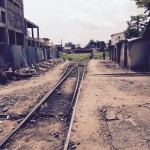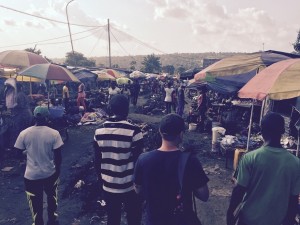 The Republic of Congo (Congo Brazzaville), like all of Central Africa is not high on most travelers’ bucket lists. The area has a reputation for being dangerous, corrupt and expensive. On top of that, there is little in the way of traditional tourist attractions. For all these reasons, most people steer clear of the region all together. But on the other hand, isn’t that what makes it interesting? We thought so.
The Republic of Congo (Congo Brazzaville), like all of Central Africa is not high on most travelers’ bucket lists. The area has a reputation for being dangerous, corrupt and expensive. On top of that, there is little in the way of traditional tourist attractions. For all these reasons, most people steer clear of the region all together. But on the other hand, isn’t that what makes it interesting? We thought so.
THE PLAN:
Congo Brazzaville tends to be prohibitively expensive, so we wanted to see if we could travel the country within a typical backpacker budget. We started our trip with little more than a general idea of where we wanted go and a goal to stick to an itinerary that any backpacker could afford.
This is a brief recount of two, non-French speaking white males as they fumble their way across The Republic of the Congo.
Our first obstacle presented itself on arrival in Brazzaville prior to even getting out of the airport. According to our immigration officer, we didn’t have the correct “Letter of Invitation” to visit the country, and this particular gentleman wanted $300 USD each as a substitute. After a 45-minute argument, we negotiated him down to $250 USD for the both of us. Not what you would call a “win”, but it was the best we could do.
Here’s a tip for anyone flying into Brazzaville, make sure you have some kind of Letter of Invitation. You can probably just create one yourself, as they most likely wont know the difference. It’s essentially one less reason for them to extract cash from you.
EXPLORING BRAZZAVILLE:
As far as large African cities go, Brazzaville is actually quite relaxing but there’s not much to keep you there for more than a few days. Instead our plan was to head north into the remote jungle villages of northern Congo, and maybe even further into the areas near the Nouabale-Ndoki National Park if time and money permitted.
 After one night in Brazzaville we made our way to the city bus station to catch a ride somewhere north. Unfortunately for us buses only travel north on certain days, so we ended up staying on the outskirts of Brazzaville for another day while inadvertently meeting a group of young guys who thought we looked too out of place to navigate the city on our own. As a result, we ended up touring a part of Brazzaville that we would normally have never seen. We walked through the dirt roads alongside stone and sheet-metal homes. We met teachers, students and shop owners along the way, and in the end got a better understanding for the people who make up the countries’ capital.
After one night in Brazzaville we made our way to the city bus station to catch a ride somewhere north. Unfortunately for us buses only travel north on certain days, so we ended up staying on the outskirts of Brazzaville for another day while inadvertently meeting a group of young guys who thought we looked too out of place to navigate the city on our own. As a result, we ended up touring a part of Brazzaville that we would normally have never seen. We walked through the dirt roads alongside stone and sheet-metal homes. We met teachers, students and shop owners along the way, and in the end got a better understanding for the people who make up the countries’ capital.
Over the course of the next day we learned as much as we could about Congolese culture and the current state of affairs in the country. It was interesting to learn that while our goal was to get out and see their remote villages, they wanted nothing to do with that side of their country. They were more proud of their newly built football stadium than anything resembling something traditional. Their focus was on studying, hip hop music, how to meet girls and get a good paying job, all things that felt very familiar. But more than anything, they were happiest about the stability their country now had.
 AIR-CON BUS INTO THE HEART OF DARKNESS:
AIR-CON BUS INTO THE HEART OF DARKNESS:
The next morning we boarded a bus heading to the small jungle village of Makua, which is one of the first towns in the Congo jungle as you head north. It’s a small non-descript village consisting of a nice hotel, a bar and a couple of restaurants that serve local Congolese dishes of cassava and chicken. Bush meat, such as monkey is also on the menu but we decided to skip it and any food born diseases that it might carry.
Leaving Makua, the road continues past dense swaths of immense Congolese jungle lined with little villages made of mud and stone until it hits the region’s major hub of Quesso. Quesso is the typical jumping off point to the Nouabale-Ndoki National Park where you can view wild elephants and gorillas, although most people who make it here simple fly in with a tour group and avoid the rest of the Congo.
Traveling overland this far was not without obstacles. As we made our way north over the course of about four days, we had to pass through about ten military checkpoints with approximately half of them requesting payment for passage. This unfortunately is the reality for the citizens of the Congo, a military that is rarely paid by its government and has to resort to extortion as a means of survival. Two out-of-place foreigners make the best and easiest targets.
The town of Quesso is a typical African town situated in the middle of the Congolese jungle. Up until recently it had been closed off from the rest of the country due to its main road being destroyed in the civil war. It was only **** years ago that the road was repaired and buses now frequently make the overland trip. From Quesso it’s theoretically possible to rent a vehicle to visit outlaying Pygmy villages. We attempted this, but were stopped by Congolese military and asked to pay a “fee” for crossing checkpoints. Discouraged by the number of “fees” we were dishing out, we decided to cut our losses and spend more time in Quesso drinking beer and eating cassava.
From Quesso, the next obvious stop is the Nouabale-Ndoki National Park or its nearby areas. The park itself was too expensive for us to even consider entering (Approx. $10,000 USD per week). However we knew that wild elephants could be viewed by simply staying in the adjacent village of Bomassa. So that was our next plan of action.
From the Sangha river that runs east of Quesso you can hire dugout canoes that will travel the distance to the village of Bomassa. River travel is currently the only way to access the village. After some hard and disappointing negotiations, we reached the conclusion that the boatmen would not make the journey for less that $200 USD each way. With this extraordinarily high price being well out of our budget we declined and abandoned any hope of seeing the wild elephants.
With all our Congolese plans unrealized and our time running out, we made the long journey back to Brazzaville to meet up with our friends from the city. We spent the next few days exploring the rarely visited villages around the periphery of the capital.  In the end, despite having much of our plans killed by the logistics of traveling in the Congo, we ended up leaving the country having created some great friendships and gaining a good understanding of the struggle that people live with everyday.
Our trip to The Congo turned out to be interesting and eye opening for reasons we never expected. It wasn’t about the sites or animals we saw, but more about the connections we made and the experience of navigating our way around a country that is only now recovering from a brutal civil war that tore it apart for so many years.
For those interested in traveling to The Republic of Congo on a budget, its best to be open to any situation that presents itself because nothing here is predictable. But if you have enough time and determination, you can see a part of Africa that few travelers reach and you’ll end up leaving knowing that you’ve experienced a corner of the world rarely seen by outsiders.




